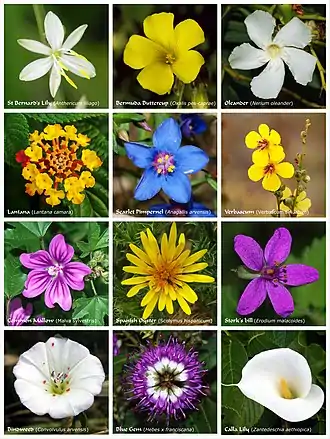Cornales
The Cornales are an order of flowering plants, early diverging among the asterids, containing about 600 species. Plants within the Cornales usually have four-parted flowers, drupaceous fruits, and inferior to half-inferior gynoecia topped with disc-shaped nectaries.
| Cornales Temporal range: | |
|---|---|
 | |
| Dove tree in flower, a species in Nyssaceae | |
| Scientific classification | |
| Kingdom: | Plantae |
| Clade: | Tracheophytes |
| Clade: | Angiosperms |
| Clade: | Eudicots |
| Clade: | Asterids |
| Order: | Cornales Link[1] |
| Families | |
Taxonomy
In the classification system of Dahlgren the Cornales were in the superorder Corniflorae (also called Cornanae). Under the APG IV system, the Cornales order includes these families:[2]
- Cornaceae (the dogwood family)
- Curtisiaceae (cape lancewood)
- Grubbiaceae (the sillyberry family)
- Hydrangeaceae (the hydrangea family)
- Hydrostachyaceae
- Loasaceae (the stickleaf family)
- Nyssaceae, (the tupelos)
The oldest fossils assigned with confidence to the order are Hironoia fusiformis, described from Coniacian age Japanese coalified fruits, and Suciacarpa starrii described from American permineralized fruits of Campanian age.[3]
Phylogeny
The Cornales order is sister to the remainder of the large and diverse asterid clade. The Cornales are highly geographically disjunct and morphologically diverse, which has led to considerable confusion regarding the proper circumscription of the groups within the order and the relationships between them.[4] Under the Cronquist system, the order comprised the families Cornaceae, Nyssaceae, Garryaceae, and Alangiaceae, and was placed among the Rosidae, but this interpretation is no longer followed. Many families and genera previously associated with the Cornales have been removed, including Garryaceae, Griselinia, Corokia, and Kaliphora, among others.[4]
Likely cladogram for Cornales:[5]
| Cornales |
| ||||||||||||||||||||||||||||||||||||
Molecular data suggest four clades are within the Cornales: Cornus-Alangium, nyssoids-mastixioids, Hydrangeaceae-Loasaceae, and Grubbia-Curtisia, with the Hydrostachyaceae in an uncertain position, possibly basal.[6] However, the relationship between these clades is unclear, and as a result of many historical taxonomic interpretations and differing opinions regarding the significance of morphological variations, rankings of taxa within the order are inconsistent.[4][6][7] These difficulties in interpreting the systematics of Cornales may represent an early and rapid diversification of the groups within the order.[6]
References
- Angiosperm Phylogeny Group (2009). "An update of the Angiosperm Phylogeny Group classification for the orders and families of flowering plants: APG III". Botanical Journal of the Linnean Society. 161 (2): 105–121. doi:10.1111/j.1095-8339.2009.00996.x.
- Angiosperm Phylogeny Group (2016). "An update of the Angiosperm Phylogeny Group classification for the orders and families of flowering plants: APG IV". Botanical Journal of the Linnean Society. 181 (1): 1–20. doi:10.1111/boj.12385. ISSN 0024-4074.
- Atkinson, B. (2016). "Early diverging asterids of the Late Cretaceous: Suciacarpa starrii gen. et sp. nov. and the initial radiation of Cornales". Botany. 94 (9): 759–771. doi:10.1139/cjb-2016-0035.
- Xiang, Q. Y., Soltis, D. E., Morgan, D. R., and Soltis, P. S. (1993). Phylogenetic relationships of Cornus L sensu lato and putative relatives inferred from rbcL sequence data. Annals of the Missouri Botanical Garden 80, 723-734.
- Based on Figure 11.10 in Soltis, Douglas; Soltis, Pamela; Endress, Peter; Chase, Mark W.; Manchester, Steven; Judd, Walter; Majure, Lucas; Mavrodiev, Evgeny (2018). Phylogeny and Evolution of the Angiosperms. University of Chicago Press. doi:10.7208/chicago/9780226441757.001.0001. ISBN 978-0-226-38361-3.
- Fan, C. Z., and Xiang, Q. Y. (2003). Phylogenetic analyses of Cornales based on 26S rRNA and combined 26S rDNA-matK-rbcL sequence data. American Journal of Botany 90, 1357-1372.
- Eyde, R. H. (1988). Comprehending Cornus - puzzles and progress in the systematics of the dogwoods. Botanical Review 54, 233-351.
